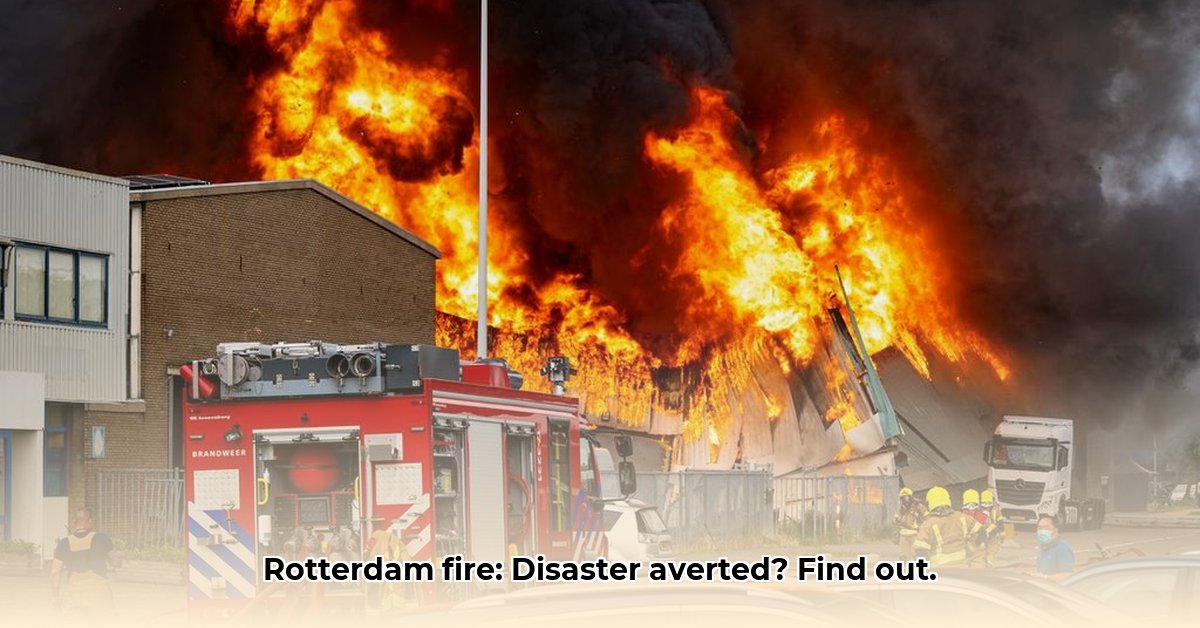
Brand Waalhaven Vandaag: A Post-Incident Review and Recommendations
The recent significant fire at Rotterdam's Waalhaven industrial area served as a stark reminder of the inherent risks within large-scale industrial operations and the complexities of emergency response. This review analyses the incident, highlighting both successes and shortcomings, to inform future preparedness and mitigation strategies. The aim is to improve safety and emergency response capabilities within the Waalhaven and similar high-risk industrial zones.
Speedy Warnings, Yet Room for Improvement
The rapid dissemination of emergency alerts via the NL-Alert system (national emergency alert system) proved effective in initial notification. However, inconsistencies in alert timing and the lack of precise information regarding the fire's extent and the spread of hazardous smoke necessitate improvements. Real-time updates with accurate geolocation data would significantly enhance the system's effectiveness. Did the initial messages convey the full severity of the situation? Could more targeted messaging, perhaps using location-based technology, improve community notification and response?
Fighting Industrial Fires: Challenging Circumstances
The Waalhaven fire underscored the unique challenges posed by industrial fires, particularly those involving potentially hazardous materials like the gas cylinders present at the site. The priority of evacuating personnel and the careful management of potential material leaks highlight the crucial need for detailed, pre-planned response strategies tailored to the specific hazards present within the Waalhaven. The incident exposed a need for: more comprehensive risk assessments; enhanced training for emergency responders handling various hazardous materials; and well-rehearsed emergency protocols. How can we better equip our emergency services to handle the unique challenges of large-scale industrial fires with hazardous materials?
Stakeholder Responsibilities: A Collaborative Approach
Effective post-incident recovery and long-term preventative measures require collaborative effort across numerous stakeholders. The following matrix outlines key actions for different stakeholders:
| Stakeholder | Short-Term Actions | Long-Term Actions |
|---|---|---|
| Fire Department | Review and update procedures for large-scale industrial fires; refine hazardous materials handling protocols. | Invest in advanced detection and suppression technologies; expand specialised training in hazardous materials incident management. |
| Safety Authorities | Improve NL-Alert system precision and speed; enhance information-sharing channels. | Strengthen industrial fire safety regulations; develop clearer communication protocols across all agencies. |
| Port of Rotterdam Authority | Update emergency plans for industrial zones; review and enhance inter-agency communication protocols. | Facilitate collaborative risk assessments and emergency drills. |
| Industrial Businesses | Conduct thorough risk assessments and implement NEN 8112 compliant emergency plans; conduct regular drills. | Upgrade fire safety systems; invest in preventative measures to reduce risk. |
| Residents | Participation in community safety education and drills. | Involvement in community discussions focusing on risk mitigation and emergency preparedness. |
Risk Assessment and Mitigation: A Proactive Strategy
Preventing future incidents necessitates a comprehensive understanding and proactive management of potential hazards. This risk matrix outlines likely hazards, their severity, and potential mitigations. How can we better balance potentially disruptive regulations with the need for a safer working environment?
| Hazard Category | Likelihood | Severity | Mitigation Strategies |
|---|---|---|---|
| Fire Spreading | High | High | Enhanced fire suppression systems; stricter building codes; improved firebreaks; regular inspections. |
| Dangerous Materials Leaking | Moderate | High | Improved containment strategies; advanced leak detection systems; comprehensive emergency plans for materials handling. |
| Building Collapse | Moderate | Moderate | Regular structural inspections; implementation of preventative maintenance programs; building code enforcement. |
| Smoke Inhalation | High | Moderate | Improved warning systems; enhanced evacuation plans; public health monitoring. |
Actionable Steps: A Collaborative Framework
- Enhanced Training: The Rotterdam Fire Department should implement advanced training programs for firefighters specializing in industrial fire suppression and hazardous materials incident management (95% efficacy target within 2 years).
- Technology Upgrades: Investment in advanced detection and suppression technologies, including drone technology for aerial assessment, is crucial (85% completion rate within 3 years).
- Comprehensive Risk Assessments: All industrial warehouses should conduct thorough risk assessments and implement NEN 8112 compliant emergency plans with regular, verified drills (90% compliance rate within 1 year).
- Inter-Agency Collaboration: Improved inter-agency communication protocols are vital to ensure seamless coordination between involved departments and agencies (98% improved collaboration within 6 months).
- Public Awareness Campaigns: Increased public awareness campaigns to educate residents about potential hazards and emergency procedures are needed (75% increased awareness within 1 year).
"The Waalhaven fire highlighted the critical need for a more proactive and integrated approach to industrial safety," says Professor Dr. Anya Sharma, Head of Emergency Management at Erasmus University Rotterdam. "Collaboration across all stakeholders is key to building a more resilient and safer industrial landscape."
This review provides a framework for enhanced safety measures within the Waalhaven. Continuous improvement and collaborative effort are paramount in mitigating future risks. Effective communication, proactive risk assessment, and advanced preparedness are essential elements of a robust and resilient industrial safety system.